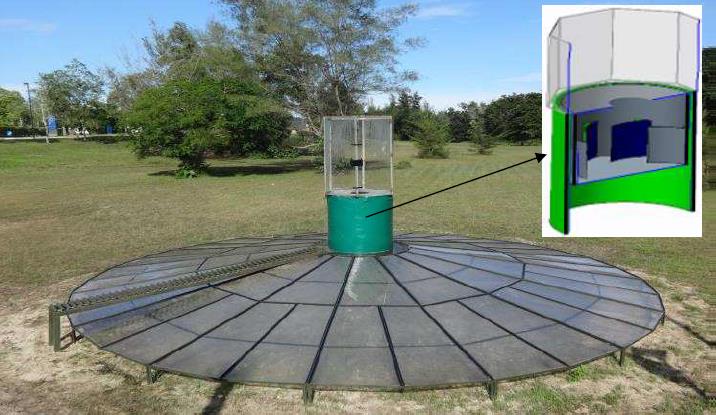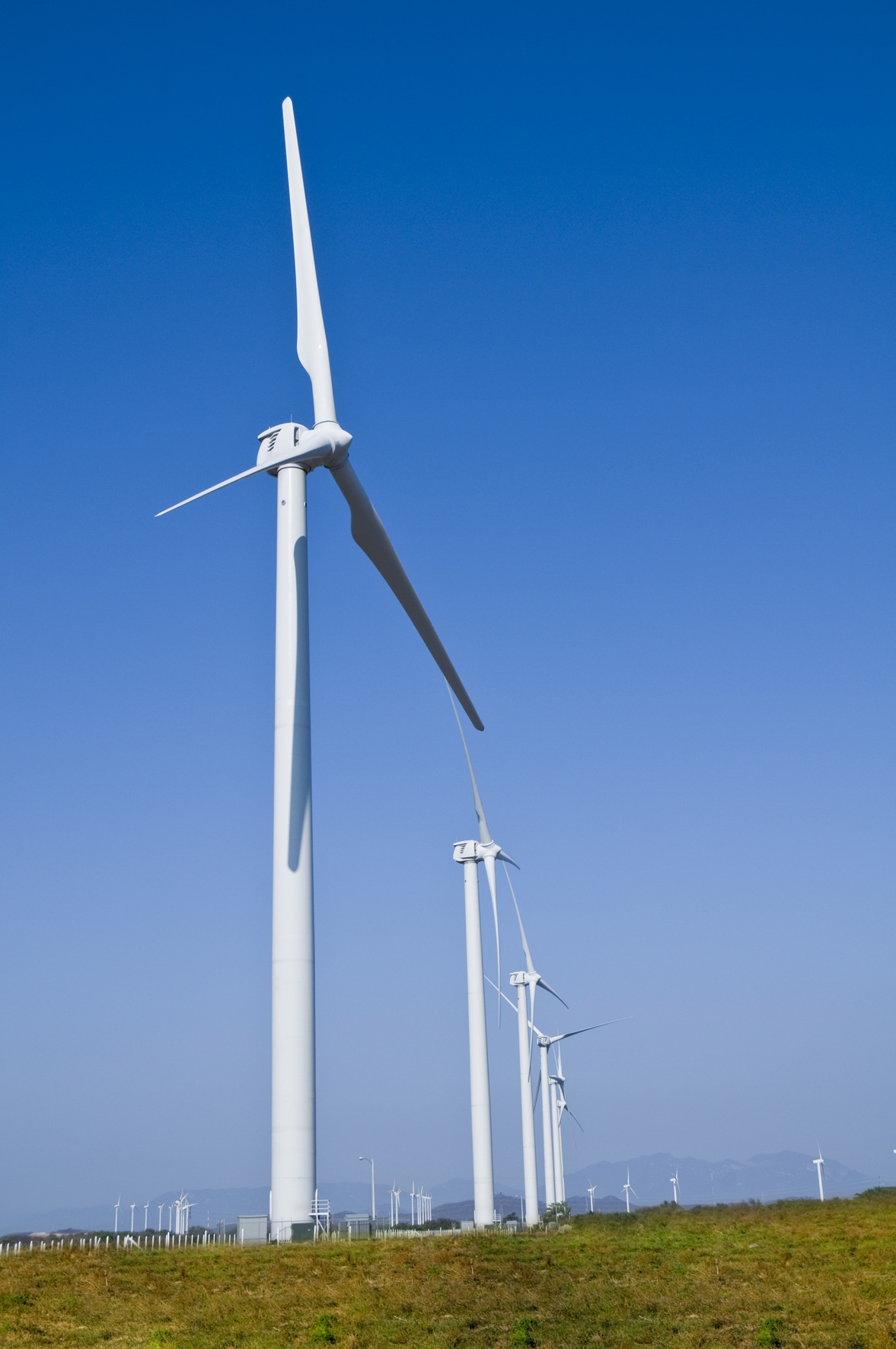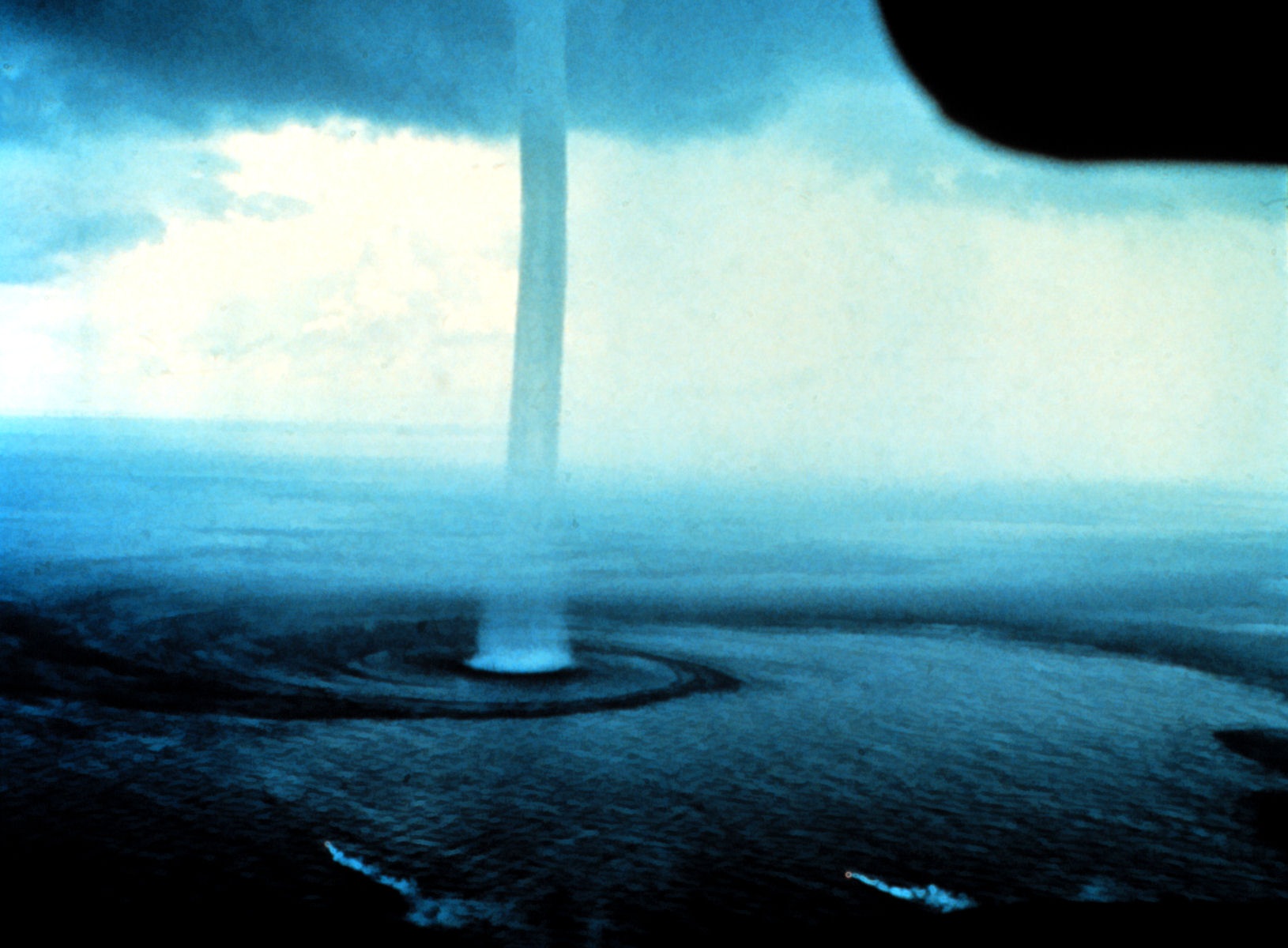|
Atmospheric Vortex Engine
The concept of a vortex engine or atmospheric vortex engine (AVE), independently proposed by Norman Louat and Louis M. Michaud, aims to replace large physical chimneys with a vortex of air created by a shorter, less-expensive structure. The AVE induces ground-level vorticity, resulting in a vortex similar to a naturally occurring landspout or waterspout. Michaud's patent claims that the main application is that the air flow through the louvers at the base will drive low-speed air turbines, generating twenty percent additional electric power from the heat normally wasted by conventional power plants. That is, the vortex engine's proposed main application is as a "bottoming cycle" for large power plants that need cooling towers. The application proposed by Louat in his patent claims is to provide a less-expensive alternative to a physical solar updraft tower. In this application, the heat is provided by a large area of ground heated by the sun and covered by a transparent surface ... [...More Info...] [...Related Items...] OR: [Wikipedia] [Google] [Baidu] |
Chimney
A chimney is an architectural ventilation structure made of masonry, clay or metal that isolates hot toxic exhaust gases or smoke produced by a boiler, stove, furnace, incinerator, or fireplace from human living areas. Chimneys are typically vertical, or as near as possible to vertical, to ensure that the gases flow smoothly, drawing air into the combustion in what is known as the stack, or chimney effect. The space inside a chimney is called the ''flue''. Chimneys are adjacent to large industrial refineries, fossil fuel combustion facilities or part of buildings, steam locomotives and ships. In the United States, the term ''smokestack industry'' refers to the environmental impacts of burning fossil fuels by industrial society, including the electric industry during its earliest history. The term ''smokestack'' (colloquially, ''stack'') is also used when referring to locomotive chimneys or ship chimneys, and the term ''funnel'' can also be used. The height of a chim ... [...More Info...] [...Related Items...] OR: [Wikipedia] [Google] [Baidu] |
Emerging Technologies
Emerging technologies are technologies whose development, practical applications, or both are still largely unrealized. These technologies are generally new but also include older technologies finding new applications. Emerging technologies are often perceived as capable of changing the status quo. Emerging technologies are characterized by radical novelty (in application even if not in origins), relatively fast growth, coherence, prominent impact, and uncertainty and ambiguity. In other words, an emerging technology can be defined as "a radically novel and relatively fast growing technology characterised by a certain degree of coherence persisting over time and with the potential to exert a considerable impact on the socio-economic domain(s) which is observed in terms of the composition of actors, institutions and patterns of interactions among those, along with the associated knowledge production processes. Its most prominent impact, however, lies in the future and so in the ... [...More Info...] [...Related Items...] OR: [Wikipedia] [Google] [Baidu] |
Energy Conversion
Energy transformation, also known as energy conversion, is the process of changing energy from one form to another. In physics, energy is a quantity that provides the capacity to perform work or moving, (e.g. Lifting an object) or provides heat. In addition to being converted, according to the law of conservation of energy, energy is transferable to a different location or object, but it cannot be created or destroyed. The energy in many of its forms may be used in natural processes, or to provide some service to society such as heating, refrigeration, lighting or performing mechanical work to operate machines. For example, to heat a home, the furnace burns fuel, whose chemical potential energy is converted into thermal energy, which is then transferred to the home's air to raise its temperature. Limitations in the conversion of thermal energy Conversions to thermal energy from other forms of energy may occur with 100% efficiency. Conversion among non-thermal forms of energy m ... [...More Info...] [...Related Items...] OR: [Wikipedia] [Google] [Baidu] |
Sustainable Energy
Energy is sustainable if it "meets the needs of the present without compromising the ability of future generations to meet their own needs". Most definitions of sustainable energy include considerations of environmental aspects such as greenhouse gas emissions and social and economic aspects such as energy poverty. Renewable energy sources such as wind, hydroelectric power, solar, and geothermal energy are generally far more sustainable than fossil fuel sources. However, some renewable energy projects, such as the clearing of forests to produce biofuels, can cause severe environmental damage. The role of non-renewable energy sources in sustainable energy has been controversial. Nuclear power is a low-carbon source whose historic mortality rates are comparable to wind and solar, but its sustainability has been debated because of concerns about radioactive waste, nuclear proliferation, and accidents. Switching from coal to natural gas has environmental benefits, including a ... [...More Info...] [...Related Items...] OR: [Wikipedia] [Google] [Baidu] |
Power Station Technology
Power most often refers to: * Power (physics), meaning "rate of doing work" ** Engine power, the power put out by an engine ** Electric power * Power (social and political), the ability to influence people or events ** Abusive power Power may also refer to: Mathematics, science and technology Computing * IBM POWER (software), an IBM operating system enhancement package * IBM POWER architecture, a RISC instruction set architecture * Power ISA, a RISC instruction set architecture derived from PowerPC * IBM Power microprocessors, made by IBM, which implement those RISC architectures * Power.org, a predecessor to the OpenPOWER Foundation * SGI POWER Challenge, a line of SGI supercomputers Mathematics * Exponentiation, "''x'' to the power of ''y''" * Power function * Power of a point * Statistical power Physics * Magnification, the factor by which an optical system enlarges an image * Optical power, the degree to which a lens converges or diverges light Social sciences and polit ... [...More Info...] [...Related Items...] OR: [Wikipedia] [Google] [Baidu] |
Waterspout
A waterspout is an intense columnar vortex (usually appearing as a funnel cloud, funnel-shaped cloud) that occurs over a body of water. Some are connected to a cumulus congestus cloud, some to a cumuliform cloud and some to a cumulonimbus cloud. In the common form, it is a non-supercell tornado over water having a five-part life cycle: formation of a dark spot on the water surface, spiral pattern on the water surface, formation of a spray ring, development of the visible condensation funnel, and ultimately, decay. Most waterspouts do not suck up water; they are small and weak rotating columns of air over water. Although they are most often weaker than their land counterparts, stronger versions spawned by mesocyclones do occur. While waterspouts form mostly in tropical and subtropical areas, other areas also report waterspouts, including Europe, Western Asia (the Middle East), Australia, New Zealand, the Great Lakes, Antarctica, and on rare occasions, the Great Salt Lake, amon ... [...More Info...] [...Related Items...] OR: [Wikipedia] [Google] [Baidu] |
Landspout
__NOTOC__ Landspout is a term created by atmospheric scientist Howard B. Bluestein in 1985 for a kind of tornado not associated with a mesocyclone. The ''Glossary of Meteorology'' defines a landspout as : "Colloquial expression describing tornadoes occurring with a parent cloud in its growth stage and with its vorticity originating in the boundary layer. : The parent cloud does not contain a preexisting mid-level mesocyclone. The landspout was so named because it looks like "a weak Florida Keys waterspout over land." Landspouts are typically weaker than mesocyclone associated tornadoes spawned within supercell thunderstorms, in which the strongest tornadoes form. Characteristics Landspouts are a type of tornado that forms during the growth stage of a cumulus congestus or occasionally a cumulonimbus cloud when an updraft stretches boundary layer vorticity upward into a vertical axis and tightens it into a strong vortex. These generally are smaller and weaker than supercell torn ... [...More Info...] [...Related Items...] OR: [Wikipedia] [Google] [Baidu] |
Solar Updraft Tower
The solar updraft tower (SUT) is a design concept for a renewable-energy power plant for generating electricity from low temperature solar heat. Sunshine heats the air beneath a very wide greenhouse-like roofed collector structure surrounding the central base of a very tall chimney tower. The resulting convection causes a hot air updraft in the tower by the chimney effect. This airflow drives wind turbines, placed in the chimney updraft or around the chimney base, to produce electricity. As of mid 2018, although several prototype models have been built, no full-scale practical units are in operation. Scaled-up versions of demonstration models are planned to generate significant power. They may also allow development of other applications, such as to agriculture or horticulture, to water extraction or distillation, or to improvement of urban air pollution. Commercial investment may have been discouraged by the high initial cost of building a very large novel structure, the large ... [...More Info...] [...Related Items...] OR: [Wikipedia] [Google] [Baidu] |
Popular Science
''Popular Science'' (also known as ''PopSci'') is an American digital magazine carrying popular science content, which refers to articles for the general reader on science and technology subjects. ''Popular Science'' has won over 58 awards, including the American Society of Magazine Editors awards for its journalistic excellence in 2003 (for General Excellence), 2004 (for Best Magazine Section), and 2019 (for Single-Topic Issue). With roots beginning in 1872, ''Popular Science'' has been translated into over 30 languages and is distributed to at least 45 countries. Early history ''The Popular Science Monthly'', as the publication was originally called, was founded in May 1872 by Edward L. Youmans to disseminate scientific knowledge to the educated layman. Youmans had previously worked as an editor for the weekly ''Appleton's Journal'' and persuaded them to publish his new journal. Early issues were mostly reprints of English periodicals. The journal became an outlet for writings ... [...More Info...] [...Related Items...] OR: [Wikipedia] [Google] [Baidu] |
Utah
Utah ( , ) is a state in the Mountain West subregion of the Western United States. Utah is a landlocked U.S. state bordered to its east by Colorado, to its northeast by Wyoming, to its north by Idaho, to its south by Arizona, and to its west by Nevada. Utah also touches a corner of New Mexico in the southeast. Of the fifty U.S. states, Utah is the 13th-largest by area; with a population over three million, it is the 30th-most-populous and 11th-least-densely populated. Urban development is mostly concentrated in two areas: the Wasatch Front in the north-central part of the state, which is home to roughly two-thirds of the population and includes the capital city, Salt Lake City; and Washington County in the southwest, with more than 180,000 residents. Most of the western half of Utah lies in the Great Basin. Utah has been inhabited for thousands of years by various indigenous groups such as the ancient Puebloans, Navajo and Ute. The Spanish were the first Europe ... [...More Info...] [...Related Items...] OR: [Wikipedia] [Google] [Baidu] |
Kibibyte
The byte is a unit of digital information that most commonly consists of eight bits. Historically, the byte was the number of bits used to encode a single character of text in a computer and for this reason it is the smallest addressable unit of memory in many computer architectures. To disambiguate arbitrarily sized bytes from the common 8-bit definition, network protocol documents such as The Internet Protocol () refer to an 8-bit byte as an octet. Those bits in an octet are usually counted with numbering from 0 to 7 or 7 to 0 depending on the bit endianness. The first bit is number 0, making the eighth bit number 7. The size of the byte has historically been hardware-dependent and no definitive standards existed that mandated the size. Sizes from 1 to 48 bits have been used. The six-bit character code was an often-used implementation in early encoding systems, and computers using six-bit and nine-bit bytes were common in the 1960s. These systems often had memory words ... [...More Info...] [...Related Items...] OR: [Wikipedia] [Google] [Baidu] |






